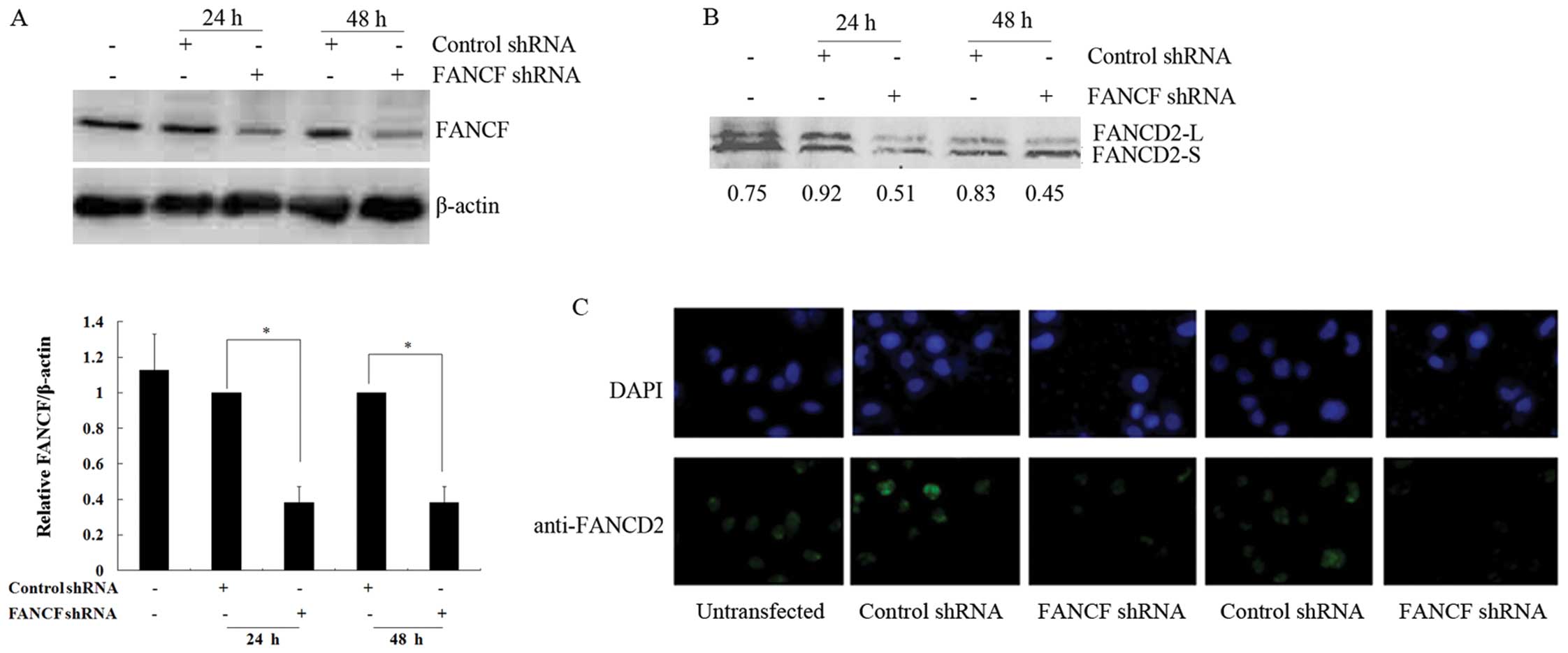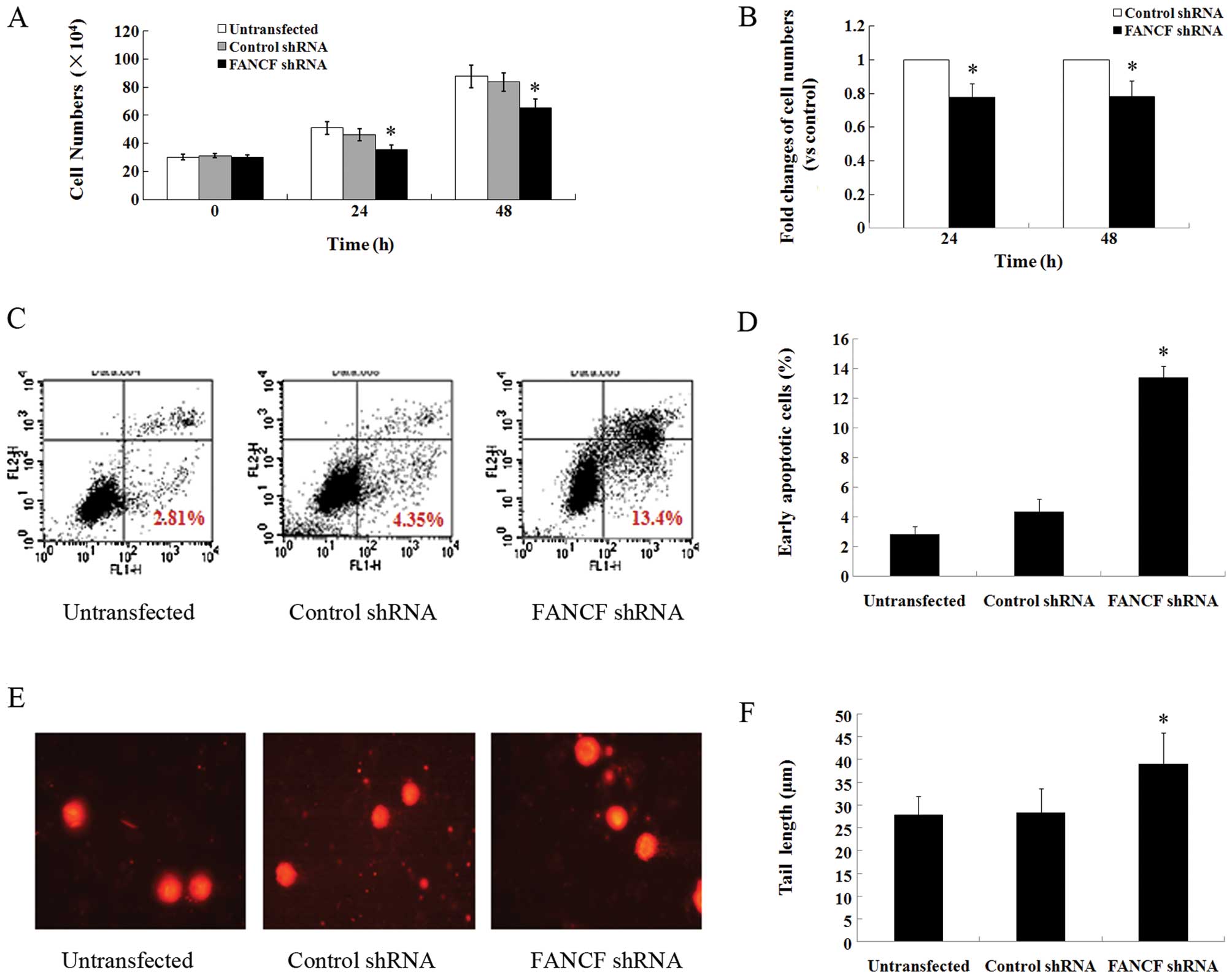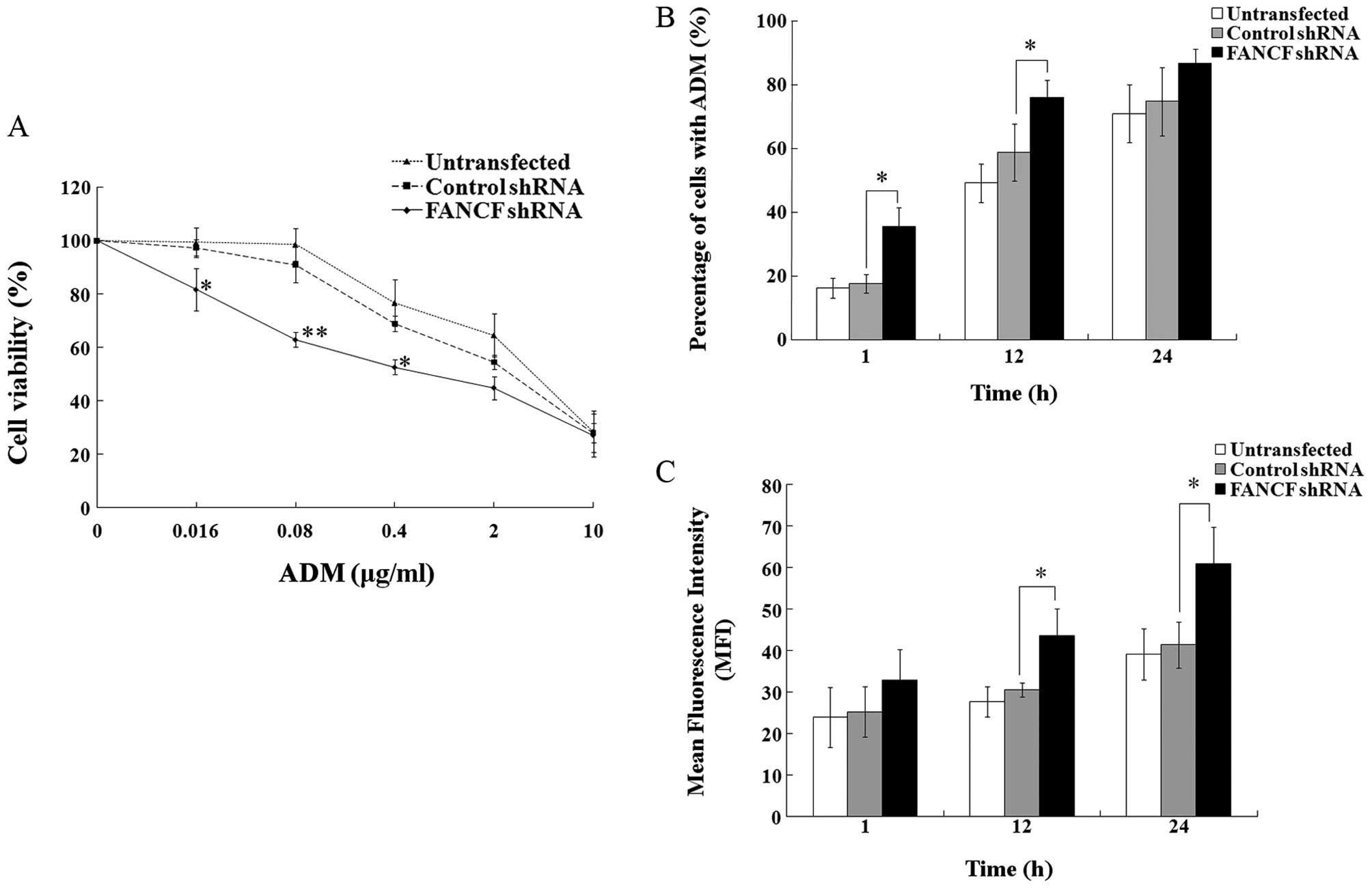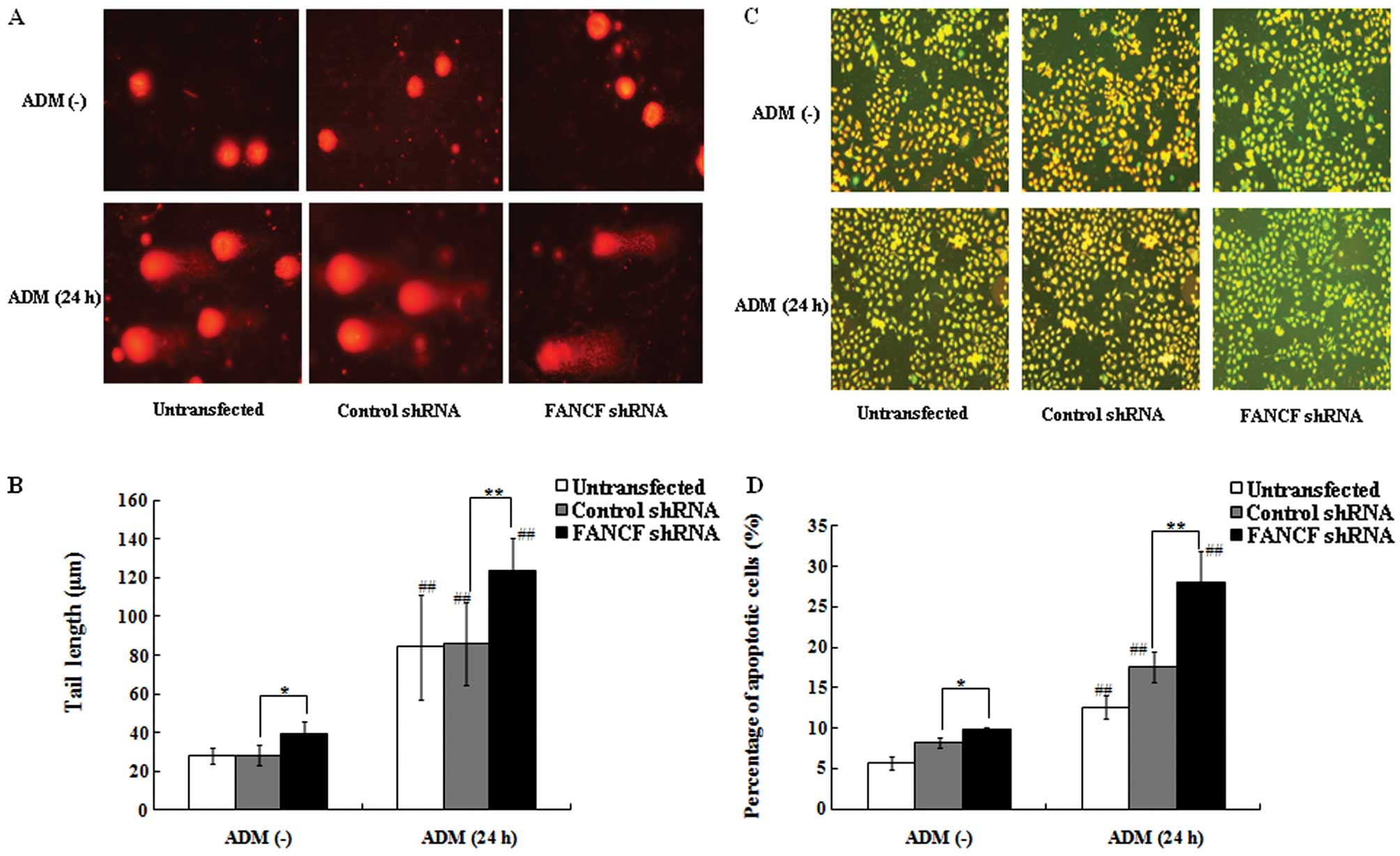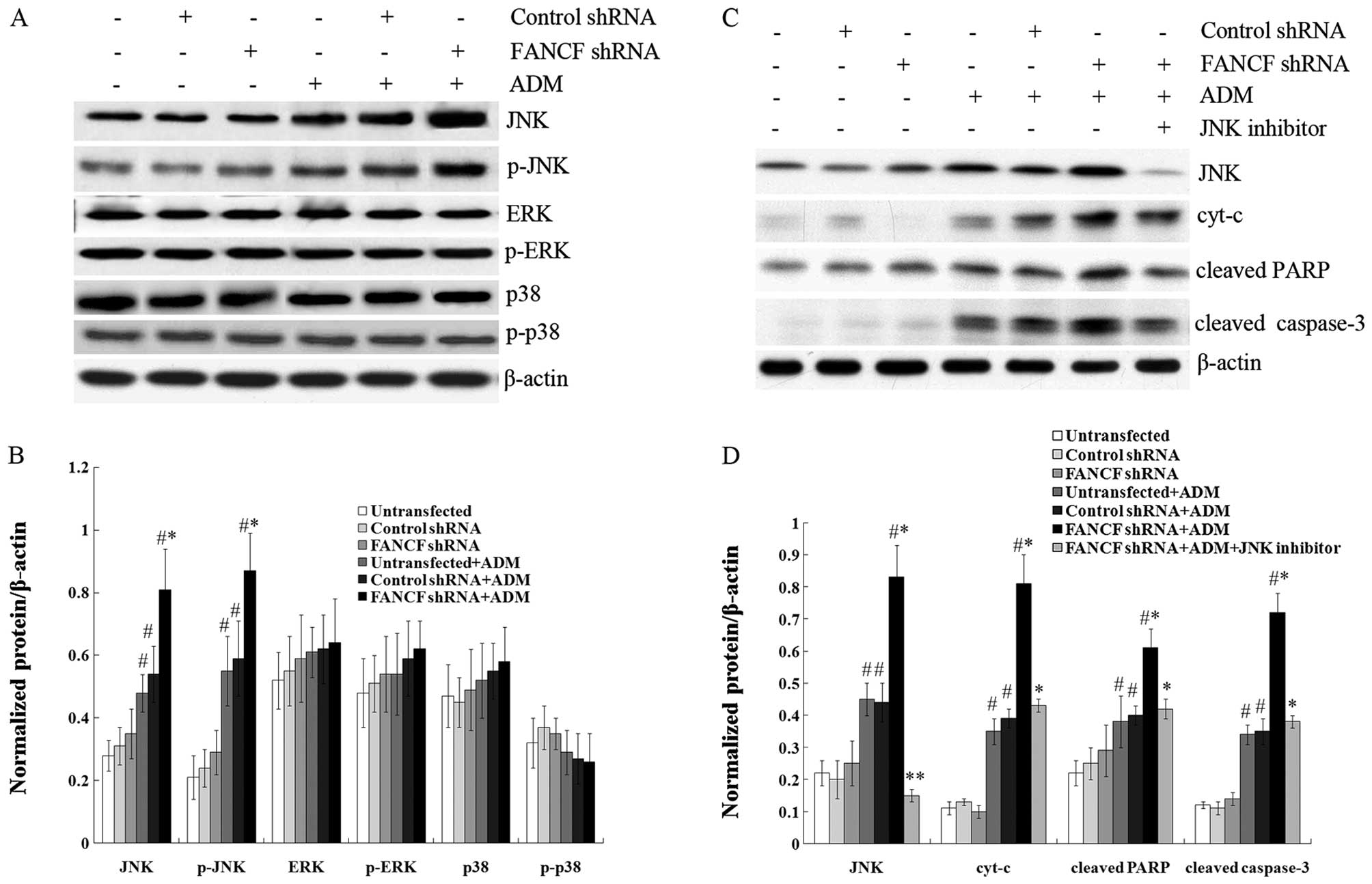|
1
|
Permuth-Wey J and Sellers TA: Epidemiology
of ovarian cancer. Methods Mol Biol. 472:413–437. 2009. View Article : Google Scholar
|
|
2
|
Marchetti C, Pisano C, Facchini G, et al:
First-line treatment of advanced ovarian cancer: current research
and perspectives. Expert Rev Anticancer Ther. 10:47–60. 2010.
View Article : Google Scholar : PubMed/NCBI
|
|
3
|
Orth K, Hung J, Gazdar A, et al: Genetic
instability in human ovarian cancer cell lines. Proc Natl Acad Sci
USA. 91:9495–9499. 1994. View Article : Google Scholar : PubMed/NCBI
|
|
4
|
Matsuo K, Eno ML, Im DD, et al: Clinical
relevance of extent of extreme drug resistance in epithelial
ovarian carcinoma. Gynecol Oncol. 116:61–65. 2010. View Article : Google Scholar : PubMed/NCBI
|
|
5
|
Jacquemont C, Simon JA, D’Andrea AD and
Taniguchi T: Non-specific chemical inhibition of the Fanconi anemia
pathway sensitizes cancer cells to cisplatin. Mol Cancer.
11:262012. View Article : Google Scholar : PubMed/NCBI
|
|
6
|
Hucl T and Gallmeier E: DNA repair:
exploiting the Fanconi anemia pathway as a potential therapeutic
target. Physiol Res. 60:453–465. 2011.PubMed/NCBI
|
|
7
|
Su X and Huang J: The Fanconi anemia
pathway and DNA interstrand cross-link repair. Protein Cell.
2:704–711. 2011. View Article : Google Scholar : PubMed/NCBI
|
|
8
|
Leveille F, Blom E, Medhurst AL, et al:
The Fanconi anemia gene product FANCF is a flexible adaptor
protein. J Biol Chem. 279:39421–39430. 2004. View Article : Google Scholar : PubMed/NCBI
|
|
9
|
Kowal P, Gurtan AM, Stuckert P, et al:
Structural determinants of human FANCF protein that function in the
assembly of a DNA damage signaling complex. J Biol Chem.
282:2047–2055. 2007. View Article : Google Scholar : PubMed/NCBI
|
|
10
|
Taniguchi T, Tischkowitz M, Ameziane N, et
al: Disruption of the Fanconi anemia-BRCA pathway in
cisplatin-sensitive ovarian tumors. Nat Med. 9:568–574. 2003.
View Article : Google Scholar : PubMed/NCBI
|
|
11
|
Lim SL, Smith P, Syed N, et al: Promoter
hypermethylation of FANCF and outcome in advanced ovarian cancer.
Br J Cancer. 98:1452–1456. 2008. View Article : Google Scholar : PubMed/NCBI
|
|
12
|
Wang Z, Li M, Lu S, et al: Promoter
hypermethylation of FANCF plays an important role in the occurrence
of ovarian cancer through disrupting Fanconi anemia-BRCA pathway.
Cancer Biol Ther. 5:256–260. 2006. View Article : Google Scholar : PubMed/NCBI
|
|
13
|
Chen Q, Van der Sluis PC, Boulware D, et
al: The FA/BRCA pathway is involved in melphalan-induced DNA
interstrand cross-link repair and accounts for melphalan resistance
in multiple myeloma cells. Blood. 106:698–705. 2005. View Article : Google Scholar : PubMed/NCBI
|
|
14
|
Chen CC, Taniguchi T and D’Andrea A: The
Fanconi anemia (FA) pathway confers glioma resistance to DNA
alkylating agents. J Mol Med. 85:497–509. 2007. View Article : Google Scholar : PubMed/NCBI
|
|
15
|
Valerio MR, Tagliaferrri P, Raspagliesi F,
et al: A phase II study of pegylated liposomal doxorubicin
oxaliplatin and cyclophosphamide as second-line treatment in
relapsed ovarian carcinoma. Int J Gynecol Cancer. 16:79–85. 2006.
View Article : Google Scholar : PubMed/NCBI
|
|
16
|
Sehouli J, Camara O, Schmidt M, et al:
Pegylated liposomal doxorubicin (CAELYX) in patients with advanced
ovarian cancer: results of a German multicenter observational
study. Cancer Chemother Pharmacol. 64:585–591. 2009. View Article : Google Scholar : PubMed/NCBI
|
|
17
|
Lei T, Srinivasan S, Tang Y, et al:
Comparing cellular uptake and cytotoxicity of targeted drug
carriers in cancer cell lines with different drug resistance
mechanisms. Nanomedicine. 7:324–332. 2011. View Article : Google Scholar : PubMed/NCBI
|
|
18
|
Singh NP, McCoy MT, Tice RR and Schneider
EL: A simple technique for quantitation of low levels of DNA damage
in individual cells. Exp Cell Res. 175:184–191. 1988. View Article : Google Scholar
|
|
19
|
Klaude M, Eriksson S, Nygren J and
Ahnström G: The comet assay: mechanisms and technical
considerations. Mutat Res. 363:89–96. 1996. View Article : Google Scholar : PubMed/NCBI
|
|
20
|
Gordon SM, Alon N and Buchwald M: FANCC,
FANCE, and FANCD2 form a ternary complex essential to the integrity
of the Fanconi anemia DNA damage response pathway. J Biol Chem.
280:36118–36125. 2005. View Article : Google Scholar : PubMed/NCBI
|
|
21
|
Li Y, Liu Y, Fu Y, et al: The triggering
of apoptosis in macrophages by pristine graphene through the MAPK
and TGF-beta signaling pathways. Biomaterials. 33:402–411. 2012.
View Article : Google Scholar : PubMed/NCBI
|
|
22
|
Ji C, Yang B, Yang YL, et al: Exogenous
cell-permeable C6 ceramide sensitizes multiple cancer cell lines to
doxorubicin-induced apoptosis by promoting AMPK activation and
mTORC1 inhibition. Oncogene. 29:6557–6568. 2010. View Article : Google Scholar : PubMed/NCBI
|
|
23
|
D’Andrea AD: The Fanconi anemia/BRCA
signaling pathway: disruption in cisplatin-sensitive ovarian
cancers. Cell Cycle. 2:290–292. 2003.PubMed/NCBI
|
|
24
|
Kim H and D’Andrea AD: Regulation of DNA
cross-link repair by the Fanconi anemia/BRCA pathway. Genes Dev.
26:1393–1408. 2012. View Article : Google Scholar : PubMed/NCBI
|
|
25
|
Garcia-Higuera I, Taniguchi T, Ganesan S,
et al: Interaction of the Fanconi anemia proteins and BRCA1 in a
common pathway. Mol Cell. 7:249–262. 2001. View Article : Google Scholar : PubMed/NCBI
|
|
26
|
Bogliolo M, Lyakhovich A, Callén E,
Castellà M, et al: Histone H2AX and Fanconi anemia FANCD2 function
in the same pathway to maintain chromosome stability. EMBO J.
26:1340–1351. 2007. View Article : Google Scholar : PubMed/NCBI
|
|
27
|
Joenje H and Patel KJ: The emerging
genetic and molecular basis of Fanconi anaemia. Nat Rev Genet.
2:446–457. 2001. View Article : Google Scholar : PubMed/NCBI
|
|
28
|
Burden DA and Osheroff N: Mechanism of
action of topoisomerase II and drugs targeted to the enzyme.
Biochim Biophys Acta. 1400:139–154. 1998. View Article : Google Scholar : PubMed/NCBI
|
|
29
|
Clementi ME, Giardina B, Di Stasio E, et
al: Doxorubicin-derived metabolites induce release of cytochrome C
and inhibition of respiration on cardiac isolated mitochondria.
Anticancer Res. 23:2445–2450. 2003.PubMed/NCBI
|
|
30
|
Green PS and Leeuwenburgh C: Mitochondrial
dysfunction is an early indicator of doxorubicin-induced apoptosis.
Biochim Biophys Acta. 1588:94–101. 2002. View Article : Google Scholar : PubMed/NCBI
|
|
31
|
Bar-Joseph H, Ben-Aharon I, Rizel S, et
al: Doxorubicin-induced apoptosis in germinal vesicle (GV) oocytes.
Reprod Toxicol. 30:566–572. 2010. View Article : Google Scholar : PubMed/NCBI
|
|
32
|
Naci D, El Azreq MA, Chetoui N, et al:
α2β1 integrin promotes chemoresistance against doxorubicin in
cancer cells through extracellular signal-regulated kinase (ERK). J
Biol Chem. 287:17065–17076. 2012.
|
|
33
|
Aroui S, Mili D, Brahim S, et al:
Doxorubicin coupled to penetratin promotes apoptosis in CHO cells
by a mechanism involving c-Jun NH2-terminal kinase. Biochem Biophys
Res Commun. 396:908–914. 2010. View Article : Google Scholar : PubMed/NCBI
|
|
34
|
Budihardjo I, Oliver H, Lutter M, et al:
Biochemical pathways of caspase activation during apoptosis. Annu
Rev Cell Dev Biol. 15:269–290. 1999. View Article : Google Scholar : PubMed/NCBI
|
|
35
|
Velagapudi C, Bhandari BS, Abboud-Werner
S, et al: The tuberin/mTOR pathway promotes apoptosis of tubular
epithelial cells in diabetes. J Am Soc Nephrol. 22:262–273. 2011.
View Article : Google Scholar : PubMed/NCBI
|
|
36
|
Li M, Wang AJ and Xu JX: Redox state of
cytochrome c regulates cellular ROS and caspase cascade in
permeablized cell model. Protein Pept Lett. 15:200–205. 2008.
View Article : Google Scholar : PubMed/NCBI
|















